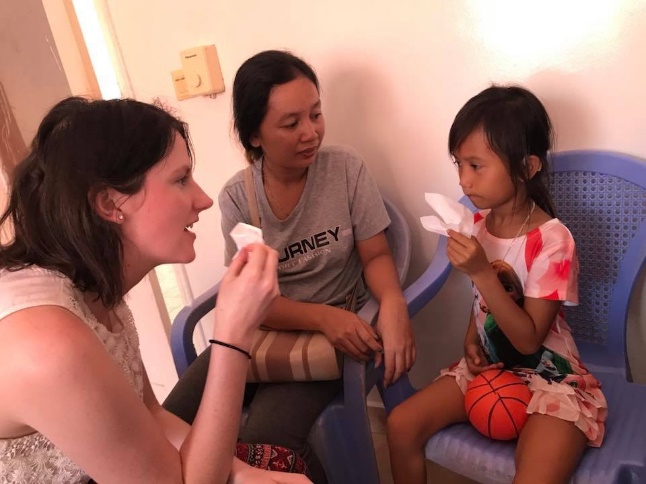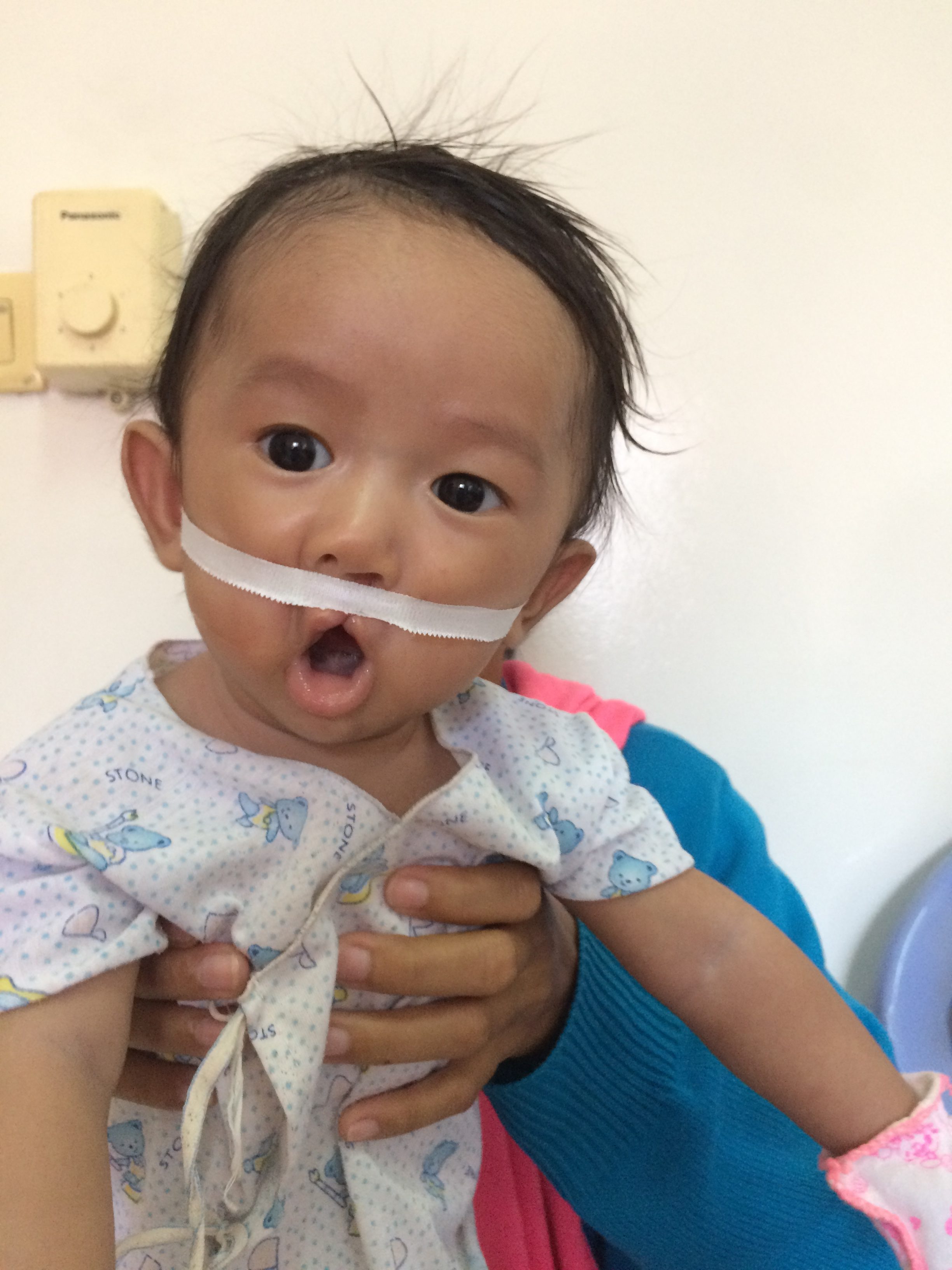
The City Cambodia Project 2017: Weeks 11 & 12

Week 11
On Monday we were at CSC. This week, there were visiting surgeons from North Korea and during the morning meeting there was a presentation on biopsies and CSC’s protocol. This was very exciting, to see professionals sharing their knowledge with their international colleagues. After the morning meeting, we showed Samnang and Vin the updated Khmer Speech Sound Assessment that we have been working on. Samnang was very happy with it. The assessment consists of pictures for the children to name, in order for a speech adviser to analyse the sounds the child makes. Samnang asked if he could have extra copies of the pictures and described how he would use them to make the assessment more interactive and fun for the child. This is a great idea, as children can easily get tired or bored during assessments and it was really encouraging to see Samnang generating innovative ideas to add to his own clinical practice.
Vin showed us some case histories that she had independently carried out during the previous week. This was another big achievement, because it indicates the sustainability of speech work continuing at CSC when we leave. We also watched Vin lead an initial appointment with a new patient. It is lovely to see her confidence growing. There is still some training to be done around ‘what speech and expressive and receptive language is’ and this is going to be our main focus for the final few weeks.
In the afternoon, we saw a sixteen year old boy who had had a hearing impairment since birth. He had never had an audiogram before, so no one knew the severity of his hearing loss, but he had no speech besides vowel-like vocalisations. This highlighted to us that while progress is happening in Cambodia, there is still a lot of educating and raising awareness around different problems to be done. We asked the Ears, Nose and Throat department to carry out an audiogram, in order to determine the type and severity of hearing loss the patient had. This was a fantastic session of multi-disciplinary team work. Initially they told us they could not do the test with him as he did not understand the instructions. We pushed for them to try it anyway and spent a long time using different ways to explain the test, using non-verbal language. This consisted of lots of drawings, gestures and pictures – it turned out that there was already a picture poster to explain to patients with hearing impairments what do to during the hearing test – but the team often forgot to use it. Once we explained how we might get the message across to the client, Vin demonstrated great persistence and use of visuals to explain it to him. Eventually he was able to do the test and we could see that he has a severe-profound hearing loss, and so was not able to hear any speech sounds. It was great to see the ENT team thinking about how to communicate in other ways than just using spoken words. A positive outcome of seeing this patient was that we were able to suggest a school for deaf children and adolescents, where he could go and be immersed in Deaf culture, through sign and being surrounded by other deaf people. His father seemed really happy with this.
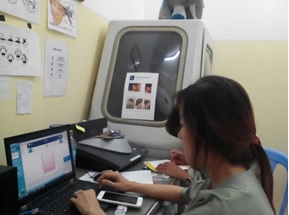
On Tuesday, we joined Smile Cambodia on their November mission at Khmer Soviet Friendship Hospital. This mission was run by a team from Singapore and consisted of two nurses and three surgeons. We, like last mission, made up the speech and language therapy team. It was lovely to be warmly greeted by Pisey, our translator from the previous mission. She fought really hard to ensure that she was our translator for this mission, as she is so interested in speech and language therapy and wants to learn more about what we can offer. Tuesday was dedicated to screening all the patients and assessing what surgery they needed and offering pre- and post-operative care. This included any speech, language and general feeding advice. One of the patients was a 21 year old, who had had his lip repaired when he was younger. We discovered that he had a complete cleft palate as well, which he thought was normal and did not realise there was a surgery to repair it. His speech was only 20 percent intelligible and when asked how he feels about his speech he got visibly upset and said that he doesn’t like to talk about it as it makes him sad. It is such a shame that awareness is still limited around cleft lip and palate, and what can be done if people know where to go. We ensured that the surgeons scheduled this young man to have his palate repaired this week and we were pleased that they took our comments on board. He was scheduled for surgery on Wednesday. Surgery will help make the resonance of his speech less nasal but will not improve the intelligibility of his speech completely. We gave him lots of activities, spoke through home speech programs with him and his older brother, and handed over advice leaflets which will help improve his speech. Unfortunately, there are poor outcomes for older patients working on their speech intelligibly, but we hope that he will see some improvements, even if they are small. He does seem motivated and his brother seems keen to help, so it’s possible that with practice he can get to a point where he feels more confident about his speech.
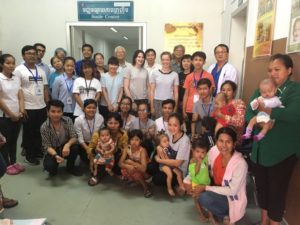
Wednesday was a very exciting day as we were presenting at Cambodia’s first National Rehabilitation Conference, organised by Raphael, the occupational therapist at National Paediatric Hospital. The purpose of the conference was to bring many different professions together to find out more about one another’s roles and to make links between professionals. The reason Raphael set up this conference was because there is an overall issue with lack of communication between organisations in Cambodia, as many are not aware of one another. There were many interesting talks, including one by Julie Ray, about the university course and possibilities for the future. There was also a separate talk about development milestones of Cambodian children.
For our presentation we spoke about what speech and language therapy is, who we work with, the City-Cambodia project and achievements, and the progress we have seen thus far. We had been a bit nervous prior to our presentation, as neither of us had ever spoken at a conference before, but we felt like it was really well received. People in the audience asked some very insightful questions, which allowed us to share more information about the project. We also had many people approach us after our talk wanting to share contact details. These people included a woman who has recently set up a new school for children with disabilities and a woman who works in an orphanage, where there are many children with communication difficulties. It is a very positive thing for the future of our project that we have all of these new contacts who the future teams can do work with. All of them seemed very keen for our team to provide speech therapy training to their organisation.
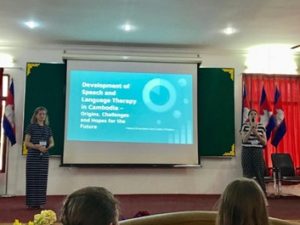
As we had made all these links and received so many email addresses of people to contact, we spent some of our administration time on Thursday morning sending emails to all of the organisations. We also planned three therapy sessions for our afternoon in the slum school, with One-2-One and planned our training with them on Friday. Our intention was to allow one of the staff members to do the therapy, with guidance and modelling from us, using the knowledge we had given them in the training session the week before. Unfortunately, when we arrived, it turned out that none of the children we wanted to see were available. One of them had moved to another province and the other two had switched to attending the morning session so weren’t in school for the afternoon. We asked if there were any other children with communication needs that we could see and they said there were not. We decided to act out what we would have done for a One-2-One staff member so that she could still learn something, and also had some fun demonstrating how you could use some of the toys we had brought in therapy.
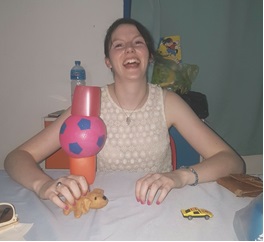
Towards the end of the afternoon a boy came in with his mother. It was difficult to figure out what the problem was and distinguish between speech, language or anxiety-related issues. Initially (all through translation) we were told that his mother was concerned because he was five years old and not speaking at all. We asked if he understands questions and follows instructions and she said he nods when he understands but does not speak. Through some interaction with the child, we discovered that he was able to speak in two-word phrases and name many different items but in sentences would miss words out. We also discovered he had some speech sound errors. He spoke quietly and did not smile and it seemed that maybe there was pressure being put on him to speak more and correct his pronunciations. We gave some language enrichment and speech modelling advice to the mother and advised her to bring him back the following week so that we could model some speech and language activities.
On Friday we were at NPH. Caitlin got the chance to observe the Occupational Therapy and Physical Therapy Department while Helena helped Dr Allin out in the feeding clinic. This was a usual fast-paced clinic with 18 patients attending in four hours, seven of those being for speech or language rather than feeding. Three of the patients had muscle tone problems and it was really encouraging to see Dr Allin independently make the decision to refer them straight to the Occupational Therapy and Physical Therapy Department. Dr Allin had attended the conference on Wednesday and it was lovely to see the message about collaborating with other professionals filtering into her clinical work. For the first time in our time volunteering in Cambodia there were three patients who as well as having cleft palates also had other diagnoses. These included Down’s Syndrome, Cerebral Palsy and Pierre Robin Syndrome. Dr Allin was not fully aware of all the speech and language difficulties that can be related to these syndromes, so this would be a good area for next year’s team to do training on.
In the OT and physio department, Caitlin got to see a range of babies, children, and adolescents receiving physiotherapy for various muscular issues. Not many of the clients were people she could give speech or language advice to, but it was useful to see how this department works and observe the team. One child had cerebral palsy and an unrepaired cleft palate, so Caitlin was able to give some general feeding advice to the mother. As there was not much speech input to be given, Caitlin was able to enjoy engaging some of the children in play while they waited to be seen.
In the afternoon, we went to One-2-One to deliver our training. This week we discussed the hierarchy and order of giving speech therapy. We demonstrated games and activities that can be used during sessions to ensure they understood how each level would be carried out. All the One-2-One staff will have a chance to practice giving speech therapy whether it be through role-play or in clinic. They were very happy to be shown the Khmer Assessment of Speech Sounds and Dr Puth agreed that it would be very useful if we gave them their own copy.
Week 12
This week, the Children’s Surgical Centre was running an Audiology mission, so the whole hospital was busy organising and helping out with the mission. As the speech therapy room doubles as the audiology room, this meant that no speech patients or training could be done. Dr Allin had a week-long conference, so her speech and feeding clinics in National Paediatric Hospital were not running this week either.
All of this provided us with some much needed extra admin time to get through the very long to-do list we had written for ourselves. As we are approaching the end of our time here, it was great to get a head start on our final reports, which will summarise our input to all the settings we have worked with this year and make recommendations for next year’s team to continue the development of each setting.
We also used our free time to arrange some meetings with the contacts we had made at the National Rehabilitation Conference in the previous week, to see if our teams may be able to help them in future. On Wednesday morning, we met with an organisation called Damnok Toek. This is an organisation that looks after vulnerable children and families and has four different locations. The one we visited houses children with disabilities who have been abandoned and their families were unable to be found. These children need around the clock care, which is provided by the staff who work days and nights on rotation. The staff team includes physiotherapists, occupational therapists, tech advisors. Sam, the man we met with, is keen to add speech therapy to the team’s repertoire. We saw a lovely sensory room for the children to enjoy and control a variety of sensory experiences. This setting would be a really great one for future teams to work with, as the staff are already having great interactions with the children, but it can clearly be seen how speech and language therapy training may help them enhance their communication. Sam also displayed great insight into how the children with disabilities may be feeling, and expressed a wish to know how to interact with them in a way that reaches them more. He felt that some of them may be “lonely”, but was unsure of how to resolve that. He was very interested to hear about the possibilities of Intensive Interaction and Parent Child Interaction training. In September 2018, when next year’s team arrive, they will be busy moving their setting to the countryside, so they are hoping for some speech and language therapy training in 2019.
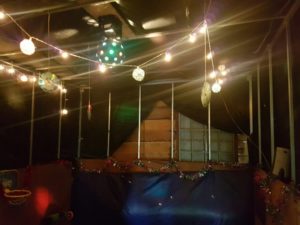
At lunch time we picked up all the newly printed and bound KASS assessments, which we will distribute to all of our settings and also to the other teams.
In the afternoon we met with Chandra at Garden of Hope Foundation. Garden of Hope Foundation is a Christian organization that helps disadvantaged girls and young women, especially girls caught in the sex industry, survivors of sexual abuse and domestic violence, and survivors of human trafficking. They have four different locations, which offer slightly different services including a schools team, with an after school programme and a home for girls vulnerable to human trafficking. The location we visited focuses on an after-care program where it aims to house, clothe, and provide food and education to disadvantaged girls. Again, this was a positive visit and meeting, where the staff were very welcoming and keen to learn more about speech and language therapy. Just two of the twelve girls that live there have communication difficulties so our teams would more than likely do just a couple of general training sessions on communication enhancement strategies. It was lovely to walk around the setting and meet all the young girls who lived there. It appeared to be a loving, homely environment and the girls seemed very cheerful, all decorating a Christmas tree together.
On Wednesday evening, we had dinner with Raphael, the occupational therapist from NPH, to discuss improved multidisciplinary working and brainstorm ideas of how to implement team training and joint sessions between different professionals. This gave us the opportunity to feed back to him about the outcomes of the conference as his aim in organising it was to bring professionals together, so it is fantastic that we have made new links through this.
On Thursday, we joined One-2-One at Cambodia Cure Medical Clinic to provide speech and language therapy to some children that we had assessed. In the beginning of our training with One-2-One, our hope was that we would give all of the staff some general training with the aim that by next year, one or two of them may show increased interest in developing their skills more specifically within speech and language therapy and becoming a speech adviser. However, it seems that this may have happened even sooner than we have hoped. Annabelle, a 17 year old girl who joined One-2-One a month ago has demonstrated excellent abilities in this area. She saw the clients with us at the clinic and provided all of the translation. We observed her remembering things from training, such as the age cluster reduction should be resolved by, and she was using excellent clinical thinking and problem-solving skills during a speech session with a child which (as often happens) was not going entirely to plan. By the end of the clinic, we were more than confident and hopeful that she may become more skilled in this area in future.
On Friday we delivered our fourth training session to One-2-One staff at their office. We decided to do this training in the form of a workshop to make it more interactive, especially important on a Friday afternoon! When we arrived, Dr Annie, one of the head people at One-2-One, who we had not met before, was present. She told us that she was going to watch the session and expressed immense gratitude for what we had done so far. She then went on to remind all of the staff about the importance of speech and language therapy and informed them that our training would be very expensive back in the UK, so it was amazing that they were getting it for free. This was flattering to hear, but made us feel slightly nervous about being observed during the training! We started off with a recap of the different stages of articulation therapy, including auditory discrimination, sound and word level. After this, we had different stations set up around the room where all staff could go and role-play delivering the stages of speech therapy that we had explained and demonstrated in the previous training session. They also practised administering the Khmer Assessment of Speech Sounds on each other to help build their confidence in carrying the assessment out in clinic. The session turned out to be a lot of fun, with all staff getting fully on board with playing the therapy games and taking turns role-playing being both child and therapist. We went around to each station to give tips for improvement and encouraged the “therapists” to give plenty of specific feedback to the “children”. We also spoke a lot throughout the session about keeping everything child-centred, building rapport with children and adjusting sessions for each individual child. Dr Annie was very complimentary of this aspect and said that even for the staff who will not be doing speech therapy, it is incredibly useful for them to learn more about working with children and having more positive interactions, as the medical mind-set here does not often allow for this.
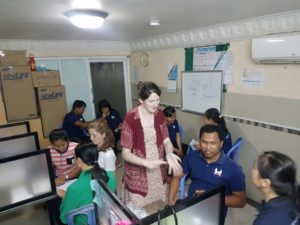
Our confidence in Annabelle receiving more direct training in the future was further extended when Dr Annie stated that she would love Annabelle specifically to learn more from us. She said that Annabelle is very bright and picks things up quickly. She would be an ideal candidate to learn the necessary skills to give speech therapy to children on their missions in the future. Annabelle seemed really happy about this and said she would like to learn more from next year onward!
